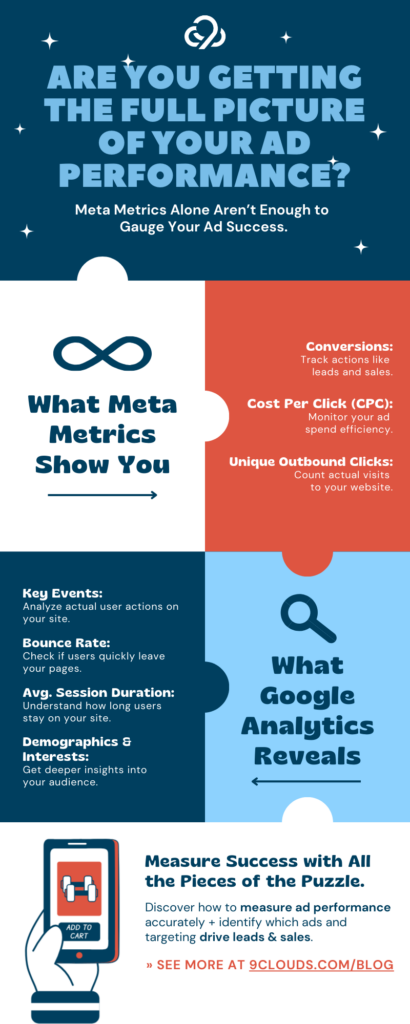
One Piece of the Puzzle: Why Checking Meta Metrics Alone Isn’t Enough
So you’re running some Facebook and Instagram ads for your business.
How do you know they’re working?
How do you know which ads or targeting are bringing in those leads and sales?
If you are only looking at your ad metrics in Meta Ads Manager, you could be missing out on crucial information about your leads and customers.
You should definitely care about those metrics in Meta (we’ll cover the important ones in a minute), but those metrics can only do just that — tell you how people engaged with the ads on Meta platforms.
That’s just one piece of the puzzle regarding your ad results.
If you want to know the behavior of those users once they leave Meta and reach your site, then you need to look at data beyond Meta Ads Manager.
That’s where Google Analytics (GA4) comes in.
Let’s go over what metrics you need to look at from Meta Ads Manager and GA4 to see the whole data puzzle (or there’s an infographic at the bottom for visual learners).
Important Metrics in Meta Ads Manager
Conversions
If you are running ads on Meta, you should already know about conversions — a.k.a. the actions you want your audience to take after viewing your ad.
Choose between leads, sales, awareness, or engagement conversion events, depending on your ads’ goal. Within those, you can track link clicks, website content views, video views, and more.
Tracking your ad conversions seems obvious, but this number helps compare month-over-month progress for your digital ad strategy and see what actions users take most often.
Cost Per Click
Take a look at your campaign cost per click (CPC). Is it close to $1?
Paying $1 for a single click on Meta means you’re paying too much. A high CPC like this would be a good indicator that you should either A) lower your budget or B) adjust your targeting choices for your campaign.
Keeping track of your CPC then helps you control your budgets and keeps your targeting focused on the best audiences.
Unique Outbound Clicks
No, this is not the same metric as link clicks.
Unique Outbound Clicks is how many of the clicks on your ad were to go to your website (so not just a like, comment or click between carousel slides).
This outbound click metric is much better to track, as clicks going to your site give you a much better idea of ad performance than just the link click metric.
Important Metrics in Google Analytics 4
Key Events
Key events are just that — the actions you want people to take on your website. (Google used to call these conversions, but changed it in April 2024).
These could be filling out forms, clicking to call your business, or making a purchase, to name a few.
Don’t worry if this number doesn’t completely match what’s shown in the ad platform. They almost never will. That being said, GA4 is a more unbiased source for numbers from all your marketing.
Keep an eye on it month by month. Is the number going up or down? What’s influencing that? What changed?
Bounce Rate
Are people staying on the page your ads sent them to? Or are they leaving right away?
A high bounce rate (meaning your user clicked the back button or left your website without clicking on anything) could be a sign that your page is loading too slowly or maybe you aren’t sending users to the best page.
Bounce rates should be less than 50% — and the lower the number, the better.
Average Session Duration
If you want to know how long users are staying on your site after seeing one of your ads, check the Average Session Duration metric in GA4.
If users aren’t staying long, it could be a sign that your pages are loading slowly or that you need to work on your website design and usability. That said, if you have a high conversion rate for a page, it might just be that people are finding what they’re looking for and don’t need to spend a lot of time (which is just fine).
Demographic and Interests
What are the users coming to your site interested in? Where are most of them located? How old are they?
These are all things Google Analytics will be able to tell you.
This information can help you make better decisions with your copy and targeting — so you know where people are the most engaged, or where to target if you want to expand your customer base.
Tip: If you run multiple campaigns on Facebook, set up separate UTM tags on those ads so you can see how each campaign performed in GA4.
Put All of the Pieces Together
We get it — tracking and organizing data takes time, and you may not have the time or the setup that’s best for your business.
If you need help keeping an eye on all of these metrics or if you would like help setting up GA4 reporting for your business, check out our reporting & ROI package or our GA4 Setup package.
Both will get you the data you need from your marketing.
I Want to See My ROI »






